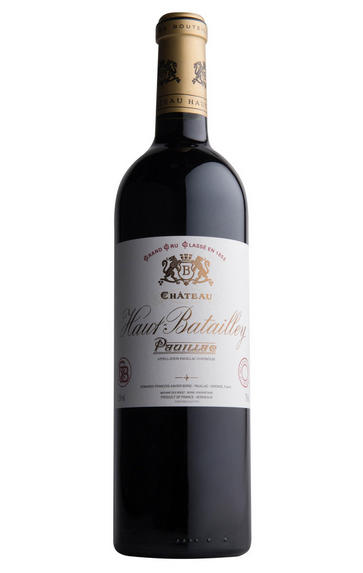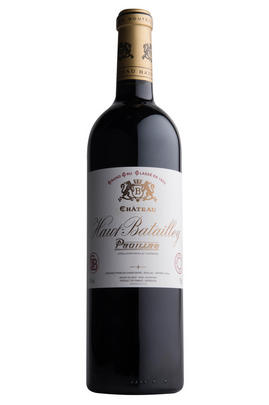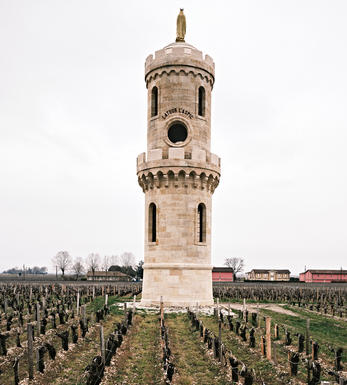
2010 Château Haut-Batailley, Pauillac, Bordeaux

Critics reviews
Wonderful spice fragrance; tender, chewy black fruit and a bitter chocolate character. Dry, rounded, firm and balanced. Very satisfying.
Drink 2016 - 2031
Richard Hemming MW, JancisRobinson.com (December 2014)
Tasted at a vertical tasting at the château.
The 2010 Haut Batailley is beginning to reach the potential I enthused about when I first tasted this from barrel. Much like the 2009 Haut-Batailley, it has a very expressive bouquet that needs a lot of coaxing from the glass. And like many 2010s it is a broody bugger, stubborn and obdurate but when you get to the palate...this is where the action is! This is where the quality positively shines through with very fine tannin: extremely pure fruit, a judicious touch of spice and a long and tender finish that is seamless. It needs 8-10 years for those aromatics to open but judging by the quality of the palate, it will be worth the wait.
Drink 2022 - 2040
Neal Martin, Wine Advocate (June 2017)
The 2010 Ch. Haut Batailley is a ripe wine, with a lovely beam of cassis and blackberry well-harnessed by seamless acidity. The rounded, enticing finish has a dash of toasty vanilla that's well-embedded.
James Molesworth, The Wine Spectator (March 2011)
This is firm and structured with blueberry and hazelnut character. Full body, with fine tannins and a juicy finish. So long and pretty. Wonderful texture.
Better after 2017
James Suckling, JamesSuckling.com (February 2013)
Sexy creme de cassis notes along with a big kiss of cedar wood, spice box and liquorice are all present in this dense, ruby/purple-coloured wine, which is lush and silky smooth, with opulence and early appeal. It can be drunk now or cellared for 15-20 years. Owned by Xavier Borie, the proprietor of the better-known Grand Puy Lacoste, this 2010 is a beauty and one of the strongest efforts he’s produced over recent years.
Robert M. Parker, Jr., Wine Advocate (February 2013)
Wonderfully elegant expression of Pauillac Cabernet, just pure, refined fruit reserved for the future. This is all sophisticated elegance for a great future.
Drink 2017 - 2040
Steven Spurrier, Stephen Brook, Michael Schuster, Decanter.com (January 2014)
About this WINE

Chateau Haut-Batailley
In the spring of 2017, the Cazes family of Ch. Lynch-Bages, acquired the Château Haut-Batailley estate from the Brest-Borie family, who had owned it since the 1930s. The fifth-growth property has approximately 22 hectares of vines, which are – on average – 35 years old.
Located in the very south of the Pauillac appellation, the property shares a similar climate to that enjoyed by the Médoc: maritime, with the Gironde estuary and the Bay of Biscay combining to act as a climate regulator and the coastal pine forests sheltering the vines from the westerly and north-westerly winds. Its near neighbours include Ch. Lynch-Bages, Ch. Pichon Lalande and Ch. Latour.
The vineyards (Cabernet Sauvignon 61%; Merlot 36%; Petit Verdot 3%) lie on deep gravel beds over limestone. It is classified as a 5ème cru classé.

Pauillac
Pauillac is the aristocrat of the Médoc boasting boasting 75 percent of the region’s First Growths and with Grand Cru Classés representing 84 percent of Pauillac's production.
For a small town, surrounded by so many familiar and regal names, Pauillac imparts a slightly seedy impression. There are no grand hotels or restaurants – with the honourable exception of the establishments owned by Jean-Michel Cazes – rather a small port and yacht harbour, and a dominant petrochemical plant.
Yet outside the town, , there is arguably the greatest concentration of fabulous vineyards throughout all Bordeaux, including three of the five First Growths. Bordering St Estèphe to the north and St Julien to the south, Pauillac has fine, deep gravel soils with important iron and marl deposits, and a subtle, softly-rolling landscape, cut by a series of small streams running into the Gironde. The vineyards are located on two gravel-rich plateaux, one to the northwest of the town of Pauillac and the other to the south, with the vines reaching a greater depth than anywhere else in the Médoc.
Pauillac's first growths each have their own unique characteristics; Lafite Rothschild, tucked in the northern part of Pauillac on the St Estèphe border, produces Pauillac's most aromatically complex and subtly-flavoured wine. Mouton Rothschild's vineyards lie on a well-drained gravel ridge and - with its high percentage of Cabernet Sauvignon - can produce (in its best years) Pauillac's most decadently rich, fleshy and exotic wine.
Latour, arguably Bordeaux's most consistent First Growth, is located in southern Pauillac next to St Julien. Its soil is gravel-rich with superb drainage, and Latour's vines penetrate as far as five metres into the soil. It produces perhaps the most long-lived wines of the Médoc.
Recommended Châteaux
Ch. Lafite-Rothschild, Ch. Latour, Ch. Mouton-Rothschild, Ch. Pichon-Longueville Baron, Ch. Pichon Longueville Comtesse de Lalande, Ch. Lynch-Bages, Ch. Grand-Puy-Lacoste, Ch, Pontet-Canet, Les Forts de Latour, Ch. Haut-Batailley, Ch. Batailley, Ch. Haut-Bages Libéral.

Cabernet Sauvignon Blend
Cabernet Sauvignon lends itself particularly well in blends with Merlot. This is actually the archetypal Bordeaux blend, though in different proportions in the sub-regions and sometimes topped up with Cabernet Franc, Malbec, and Petit Verdot.
In the Médoc and Graves the percentage of Cabernet Sauvignon in the blend can range from 95% (Mouton-Rothschild) to as low as 40%. It is particularly suited to the dry, warm, free- draining, gravel-rich soils and is responsible for the redolent cassis characteristics as well as the depth of colour, tannic structure and pronounced acidity of Médoc wines. However 100% Cabernet Sauvignon wines can be slightly hollow-tasting in the middle palate and Merlot with its generous, fleshy fruit flavours acts as a perfect foil by filling in this cavity.
In St-Emilion and Pomerol, the blends are Merlot dominated as Cabernet Sauvignon can struggle to ripen there - when it is included, it adds structure and body to the wine. Sassicaia is the most famous Bordeaux blend in Italy and has spawned many imitations, whereby the blend is now firmly established in the New World and particularly in California and Australia.


Buying options
Add to wishlist
Description
Tasted at a vertical tasting at the château.
The 2010 Haut Batailley is beginning to reach the potential I enthused about when I first tasted this from barrel. Much like the 2009 Haut-Batailley, it has a very expressive bouquet that needs a lot of coaxing from the glass. And like many 2010s it is a broody bugger, stubborn and obdurate but when you get to the palate...this is where the action is! This is where the quality positively shines through with very fine tannin: extremely pure fruit, a judicious touch of spice and a long and tender finish that is seamless. It needs 8-10 years for those aromatics to open but judging by the quality of the palate, it will be worth the wait.
Drink 2022 - 2040
Neal Martin, Wine Advocate (June 2017)
wine at a glance
Delivery and quality guarantee